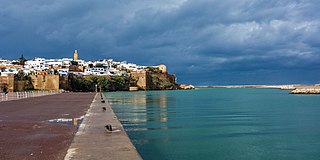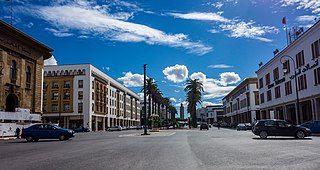Prior to 20th century
For the earlier history of the region of Rabat see Chellah
| History of Morocco |
|---|
 |
- 1150 CE - Citadel construction begins. [1]
- 1627 - Rabat and Salé form the Republic of Bou Regreg.
- 1864 - Dar al-Makhzen (palace) built.
The following is a timeline of the history of the city of Rabat, Morocco.
For the earlier history of the region of Rabat see Chellah
| History of Morocco |
|---|
 |

Rabat is the capital city of Morocco and the country's seventh-largest city with an urban population of approximately 580,000 (2014) and a metropolitan population of over 1.2 million. It is also the capital city of the Rabat-Salé-Kénitra administrative region. Rabat is located on the Atlantic Ocean at the mouth of the river Bou Regreg, opposite Salé, the city's main commuter town.
Sidi Mohammed ben Abdallahal-Khatib, known as Mohammed III, born in 1710 in Fes and died on 9 April 1790 in Meknes, was the Sultan of Morocco from 1757 to 1790 as a member of the 'Alawi dynasty. He was the governor of Marrakesh around 1750. He was also briefly sultan in 1748. He rebuilt many cities after the earthquake of 1755, including Mogador, Casablanca, and Rabat, and Abdallah Laroui described him as "the architect of modern Morocco." He also defeated the French in the Larache expedition in 1765 and expelled the Portuguese from Mazagan (al-Jadīda) in 1769. He is notable for having been the leader of one of the first nations to recognize American independence in his alliance with Luis de Unzaga 'le Conciliateur' through correspondence and Unzaga's secret intelligence service and led by his brothers-in-law Antonio and Matías de Gálvez from the Canary Islands. He was the son of Mawlay Abdallah bin Ismail and his wife a lady of the Chéraga guich tribe.

The Kasbah of the Udayas, also spelled Kasbah of the Oudaias or of the Oudayas, is a kasbah (citadel) in Rabat, Morocco. It is located on a hill at the mouth of the Bou Regreg opposite Salé, and adjacent to the Medina quarter of Rabat. It is listed, along with other sites in Rabat, as a UNESCO World Heritage Site.
The following is a timeline of the history of the city of Tunis, Tunisia.
The following is a timeline of the history of the city of Algiers, Algeria.
The following is a timeline of the history of the city of Douala, Cameroon.
The following is a timeline of the history of the city of Tangier, Morocco.
The following is a timeline of the history of the city of Casablanca, Morocco.
The following is a timeline of the history of the city of Fez, Morocco.
The following is a timeline of the history of the city of Marrakesh, Morocco.
The following is a timeline of the history of the city of Antananarivo, Madagascar.
The following is a timeline of the history of the city of Bamako, Mali.
The following is a timeline of the history of the city of Niamey, Niger.
The following is a timeline of the history of the city of Libreville, Gabon.
The following is a timeline of the history of the city of Bangui, Central African Republic.
The following is a timeline of the history of the city of Meknes, Morocco.
The following is a timeline of the history of the city of Yaoundé, Cameroon.
The following is a timeline of the history of the city of Bujumbura, Burundi.
The following is a timeline of the history of the city of Lubumbashi, Democratic Republic of the Congo.

Avenue Mohammed V, sometimes referred to by its old name Avenue Dar al-Makhzen, is a major thoroughfare in downtown Rabat, Morocco. Its main section was created under the French Protectorate in Morocco and mostly developed between 1915 and 1932, when it was also known as Cours Lyautey. At the southern end of that section is the As-Sunna Mosque, whose history dates back to the 18th century like that of the nearby royal palace or Dar el-Makhzen.
Rabat-Sale